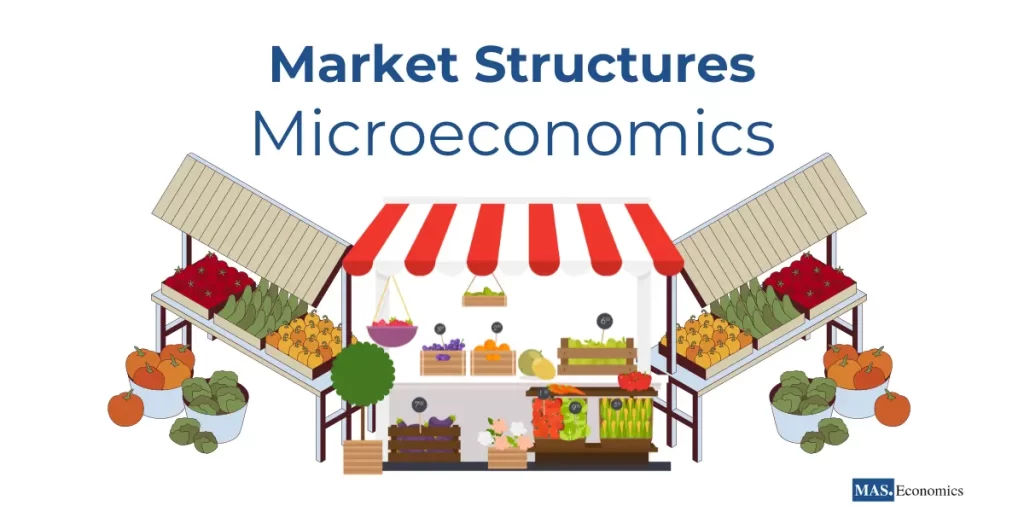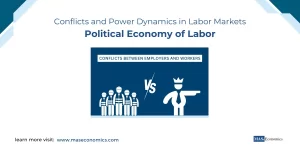Welcome to MASEconomics, your guide to the world of economics. In this blog article, we will explore the four primary market structures in microeconomics: perfect competition, monopolistic competition, oligopoly, and monopoly. We will discuss how these structures influence pricing strategies, competitive dynamics, and overall economic efficiency.
Let’s delve into each one in-depth.
Perfect Competition
In a perfect competition market, numerous firms offer identical products to a multitude of buyers. This structure is defined by unrestricted entry and exit, with prices solely determined by the forces of demand and supply. No single company wields influence over market prices; all firms must accept the same price.
Consider markets for agricultural products like wheat and corn, where many producers offer interchangeable goods, numerous buyers are present, and there are no barriers to market entry. While perfect competition is an ideal concept, it’s a rarity in reality. Most markets exhibit a blend of perfect competition features alongside elements of monopoly structures.
Key points for perfect competition:
In perfect competition, each firm is a price taker, meaning it has no market power and must accept the prevailing market price for its product.
- The firm has no market power, as the demand curve it faces is perfectly elastic.
- As production increases, costs rise due to fixed and variable expenses.
- Profit is determined by subtracting marginal cost from the market price.
- Market equilibrium is reached through the intersection of supply and demand curves.
To visualize the market dynamics in perfect competition, consider Graph 1, which illustrates the perfectly elastic demand curve faced by firms in this market.

Perfect competition promotes efficiency, as firms can freely enter or exit the market based on their profit levels. If a firm earns above-normal profits, more firms enter, increasing supply and lowering prices, and vice versa until equilibrium is reached.
In the short run, a firm can experience three types of profits:
- Supernormal profit or economic profit: Occurs when total revenue is greater than total cost or when the price is greater than average total cost.
- Subnormal profit or economic losses: Arises when the price is lower than average total cost or when total revenue is less than total cost.
- Normal profit or breakeven: Represents the profit necessary for a firm to stay in business, where total revenue equals total cost, resulting in no profit or loss.
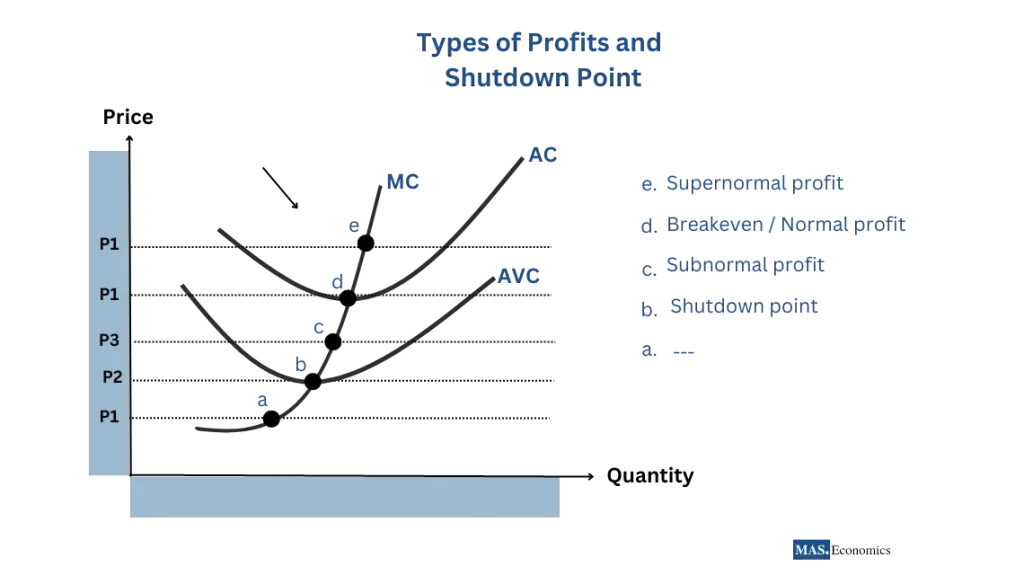
Monopolistic Competition
Monopolistic competition entails a market system with many firms producing similar but slightly differentiated products. These markets, found in consumer goods industries such as clothing, appliances, and electronics, are characterized by numerous buyers and sellers. Firms have some control over pricing but must also contend with competitors.
Unlike perfect competition, products in monopolistic competition can be slightly differentiated, leading firms to use advertising and branding to distinguish themselves. Profits here are typically higher than in perfect competition but lower than in pure monopolies.
Key points for monopolistic competition:
In monopolistic competition, firms have limited pricing power and must consider competitors’ prices.
- Firms have some pricing power but must balance it with competition.
- Costs increase with production.
- Profit is determined where demand and supply curves intersect.
- Market equilibrium is reached by combining all firms’ supply and buyers’ demand curves.
In this graph, 3 we illustrate the dynamics of a monopolistically competitive market over both the short run and long run.
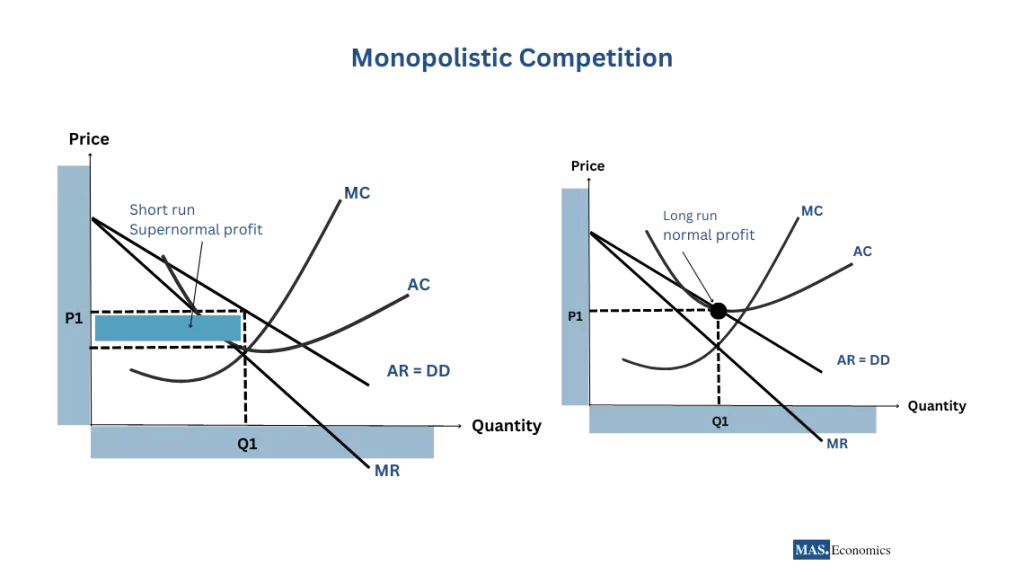
Short Run: Initially, in the short run, firms in this market structure can earn supernormal profits. This is due to the ability to charge prices above their average costs since their products are slightly differentiated, and no close substitutes are available.
Long Run: However, over the long run, the situation changes. New firms are attracted by these supernormal profits, and they enter the market. As a result, the supply of the product increases, causing the price to drop. In response, monopolistically competitive firms must lower their prices, and eventually, they can only earn normal profits.
The ease of entry into this market, with no significant barriers, allows new firms to join, leading to increased competition, reduced prices, and ultimately normal profits for all firms.
Oligopoly
In an oligopoly, a select few firms produce similar, albeit distinct, products or services. These firms are interdependent and must carefully consider their competitors’ pricing and output decisions. An example of an oligopoly is the automotive industry, where a handful of firms offer similar products and react to each other’s pricing strategies.
Oligopolistic firms can set prices above the market rate, but they must navigate the complexities of rival firms’ actions. This can lead to strategic initiatives like price collusion or price leadership, where businesses coordinate their choices to maximize profits.
Key points for oligopoly:
- Firms have significant pricing power but must consider competitors.
- Costs increase with production.
- Profit depends on setting prices above the market rate.
- Market equilibrium is determined collectively by all firms’ supply and demand curves.
Price Rigidity and Kinked Demand Curve
Price rigidity in oligopolies is explained by the kinked demand curve. This model posits that firms have no incentive to change prices because competitors will likely match a price cut but ignore a price increase. Stability in price and quantity is achieved through this price rigidity, illustrated by the kinked demand curve.
Now, let’s examine the kinked demand curve, a pivotal concept in understanding price dynamics within oligopoly markets.
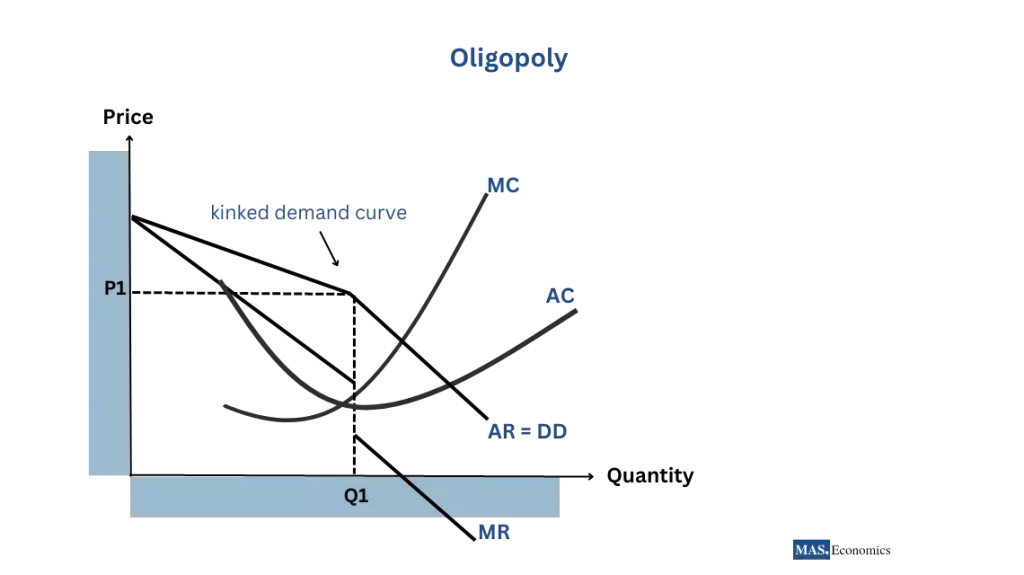
Graph 4 illustrating a kinked demand curve in an oligopoly market due to interdependence among firms. The curve bends sharply at the existing market price. Firms hesitate to raise prices as it results in significant sales loss to rivals. Similarly, lowering prices yields few new customers, as competitors follow suit. Price rigidity in oligopolies often leads to inefficiencies, including higher prices and reduced output.
Cartels
Cartels represent a cooperative effort among oligopoly firms to act together as a monopoly. These agreements aim to stabilize market shares and prices, reduce competitiveness, and eliminate promotional costs. The Organization of Petroleum Exporting Countries (OPEC) is a famous example of a cartel.
For a cartel to be successful, certain conditions must be met.
Monopoly
A monopoly arises when a single firm dominates the market, producing a product or service with no substitutes. Monopolies have complete control over pricing and typically set prices higher than market rates. Governments often intervene to regulate monopolies and prevent them from exploiting their market power.
For example, a monopoly might exist in the distribution of natural gas in a specific geographic area, where only one company provides this service.
Key points for monopoly:
- The firm has complete control over pricing due to its sole market presence.
- Costs increase with production.
- Profit depends on setting prices higher than the market rate.
- Market equilibrium is determined by the monopolist’s supply and the overall demand.
Now, let’s visualize the differences between a monopoly and perfect competition in Graph 5
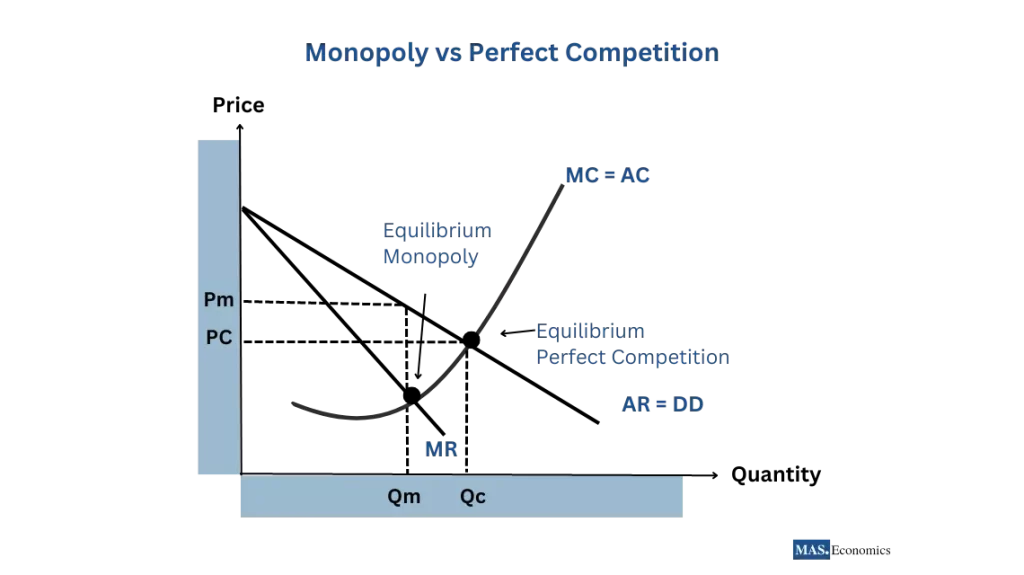
This graph compares a monopoly’s higher price (Pm) and lower quantity (Qm) with perfect competition (Pc and Qc). Monopolies earn supernormal profits due to their pricing power, represented by the shaded area.
Monopolies can lead to economic inefficiency, and government regulations aim to ensure fair pricing and competition.
Price Discrimination
Monopolies may employ price discrimination, a strategy where they charge different prices to different consumers for the same product. This practice involves segmenting the market based on factors such as age, gender, income, or nationality. Price discrimination can be categorized into three main degrees:
| Degree of Price Discrimination | Description |
|---|---|
| First Degree | The highest form of price discrimination where each individual consumer is charged a unique price based on their willingness to pay. Also known as perfect price discrimination. |
| Second Degree | Pricing varies based on the quantity or volume of goods or services purchased. Buying in larger quantities often leads to a lower per-unit price. |
| Third Degree | Consumers are grouped into categories based on characteristics like age, gender, nationality, or income. Each group is charged a different price based on perceived willingness to pay. |

| |
Additional Market Structures
These four primary market structures serve as the foundation for understanding how goods and services are exchanged in microeconomics. However, there are variations such as duopolies and monopsonies, each with its unique characteristics and implications.
Duopoly
A duopoly is a market structure consisting of two firms that produce the same product or service. These firms are interdependent, which means that the actions of one firm can influence the profits of the other.
There are two main types of duopolies: Cournot and Bertrand.
In a Cournot duopoly, the firms compete by setting output levels, whereas in a Bertrand duopoly, the firms compete by setting prices. In both duopoly types, firms can earn profits in the short run.
However, in the long run, new firms may enter the market, leading to an increase in supply and a decrease in price, resulting in only normal profits for the firms.
One of the latest and most famous examples of a duopoly is the competition between Google’s AI language model, Bard, and OpenAI’s ChatGPT.
Key points for Duopoly:
- There are two firms in the market.
- The firms produce a similar product.
- The firms are interdependent.
- The firms can earn profits in the short run.
- New firms can enter the market in the long run.
- The price of the product is determined by the interaction of the two firms.
Government regulation may be necessary to prevent duopolies from abusing their power. However, such regulation can also lead to unintended consequences, including reduced competition and innovation.
Monopsony
In a monopsony, there is only one buyer in the market, giving them complete control over purchasing a particular product or service. This situation can occur naturally or be created through government regulations, such as when a monopoly is granted to a specific company. The buyer in a monopsony has significant power over the market as they can dictate prices and terms of trade.
For instance, in a labor market with only one employer, that employer can dictate wages and negotiate lower rates than in a competitive market.
Key points for Monopsony:
- The buyer has complete control over demand and can dictate prices.
- Suppliers face an upward-sloping supply curve.
- Profit relies on setting prices lower than the market rate.
- Market equilibrium is determined by the intersection of the buyer’s demand and the total supply.
To maintain fairness in monopsony markets, government regulation is often required. This can involve setting minimum prices for suppliers or regulating the behavior of the monopsony buyer.
Summary of Market Structures
Understanding these market structures is crucial for comprehending how businesses operate, prices are set, and resources are allocated in an economy. Here’s a summary of the key characteristics of each market structure:
| Market Structure | Number of Firms | Product Differentiation | Ease of Entry/Exit | Price Determination | Profitability |
|---|---|---|---|---|---|
| Perfect Competition | Many | Homogeneous | Easy | Market price | Normal profit |
| Monopoly | One | Unique | Difficult | Price setter | Economic profit |
| Monopolistic Competition | Many | Somewhat differentiated | Easy | Slightly above marginal cost | Normal profit |
| Oligopoly | Few | Somewhat differentiated | Difficult | Collusion or Competition | Normal or economic profit |
| Duopoly | Two | Somewhat differentiated | Complex | Collusion or Competition | Normal or economic profit |
| Monopsony | One | Single buyer | Difficult | Price setter | Normal or economic profit |

|
|||||
These market structures shape our daily economic interactions. Perfect competition promotes efficiency, while monopolies and monopsonies can lead to inefficiencies. Monopolistic competition and oligopolies fall somewhere in between.
Conclusion
Market structures are the foundational elements of microeconomics, molding the behaviors of businesses and influencing consumers. A robust understanding of these structures is essential for making informed decisions in the intricate realm of economics. Whether you’re a business owner, consumer, or policy maker, comprehending market structures is the key to effectively navigating the economic landscape.
Thanks for reading! If you enjoyed this series, spread the knowledge by sharing it with friends and on social media.
Happy learning with MASEconomics!
